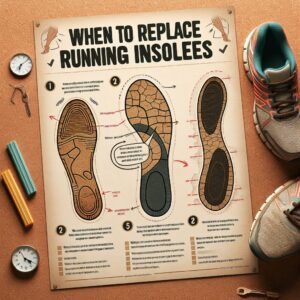
Are Gel Insoles Good for Running? Unveiling the Impact on Performance
-
Table of Contents
Gel insoles are designed to provide an extra layer of cushioning and can help with shock absorption during running, which might be beneficial for runners looking for increased comfort and impact protection. However, the suitability of gel insoles for running largely depends on personal needs and preferences, including foot type, running style, and any existing foot conditions. It’s essential to choose insoles that cater specifically to your requirements for support, cushioning, and fit within your running shoes. Although gel insoles offer the advantage of comfort and shock absorption, other materials or specific designs might provide better support and alignment for some runners, indicating that there’s no one-size-fits-all answer.
Exploring the Benefits of Gel Insoles for Running: A Deep Dive into Performance Enhancement

Running is a popular form of exercise that offers numerous health benefits, but it can also be hard on the feet and legs. This is where gel insoles come into play. These shoe inserts are designed to provide additional cushioning and support, potentially improving comfort and performance for runners. But are gel insoles good for running? Let’s delve deeper into this topic to unveil their impact on performance.
Gel insoles are made from a soft, shock-absorbing material that molds to the shape of the foot. This provides a custom fit that can enhance comfort and reduce the risk of blisters and other foot problems. The gel material also helps to distribute pressure evenly across the foot, which can reduce strain on the joints and muscles. This is particularly beneficial for runners, who often experience high levels of impact and pressure on their feet.
One of the key benefits of gel insoles for running is their ability to absorb shock. When running, each foot strike generates a force that can be up to three times the runner’s body weight. This shock can travel up the leg and cause damage to the joints and tissues. Gel insoles help to absorb this shock, reducing the impact on the body and potentially reducing the risk of injuries such as shin splints, stress fractures, and plantar fasciitis.
In addition to shock absorption, gel insoles can also provide additional arch support. This can be particularly beneficial for runners with flat feet or high arches, who may be more prone to foot and leg injuries. By supporting the arch, gel insoles can help to align the foot and leg correctly, promoting a more efficient running stride and reducing the risk of injury.
Furthermore, gel insoles can enhance running performance by reducing fatigue. The additional cushioning and support provided by the insoles can help to reduce the strain on the feet and legs, allowing runners to maintain their pace for longer periods. This can be particularly beneficial in long-distance running, where endurance is key.
However, it’s important to note that while gel insoles can offer numerous benefits, they are not a cure-all solution. Some runners may find that they do not provide enough support or cushioning, particularly for those with specific foot conditions or those who are running at a high intensity. It’s also worth noting that gel insoles can alter the fit of running shoes, which may not be comfortable for all runners.
In conclusion, gel insoles can offer a range of benefits for runners, including improved comfort, shock absorption, and arch support. They can also help to reduce fatigue and potentially enhance performance. However, they may not be suitable for all runners, and it’s important to consider individual needs and preferences when choosing running gear. As with any running equipment, it’s recommended to consult with a healthcare professional or a running specialist before making any major changes to your running routine or gear.
Gel Insoles and Running: Unraveling the Truth about Their Impact on Speed and Stamina
Running, a popular form of exercise and sport, is often associated with various physical discomforts and injuries. One common solution that runners turn to is the use of gel insoles. These are shoe inserts designed to provide additional cushioning and support to the feet. However, the question remains: are gel insoles good for running? This article aims to unravel the truth about their impact on speed and stamina.
Gel insoles, also known as shoe inserts or foot orthotics, are made from a soft, gel-like material. They are designed to fit inside a shoe, providing additional cushioning and support to the foot. The primary purpose of gel insoles is to alleviate foot discomfort and prevent injuries, particularly those related to running. They achieve this by absorbing the shock that is generated when the foot strikes the ground, thereby reducing the strain on the feet, ankles, and legs.
However, the impact of gel insoles on running performance, particularly speed and stamina, is a subject of ongoing debate. Some runners swear by them, claiming that they help to improve their speed and endurance. Others, however, argue that they can actually hinder performance.
On one hand, gel insoles can potentially enhance running speed. By providing additional cushioning, they can help to reduce the impact on the feet and legs, thereby allowing runners to maintain a faster pace for longer periods. Moreover, by improving foot comfort, they can enable runners to focus more on their speed and less on any discomfort they may be experiencing.
On the other hand, some studies suggest that gel insoles may not necessarily improve running stamina. While they can provide immediate relief from foot discomfort, they do not address the underlying causes of this discomfort, such as poor running form or inadequate foot strength. Therefore, while they may help to improve short-term performance, they may not contribute to long-term stamina.
Furthermore, gel insoles can potentially alter a runner’s natural running gait. This is because they change the way the foot strikes the ground, which can lead to an unnatural running style. Over time, this can result in decreased efficiency and potentially even injury.
In conclusion, the impact of gel insoles on running performance is complex and multifaceted. While they can provide immediate relief from foot discomfort and potentially enhance speed, their impact on stamina is less clear. Moreover, they can potentially alter a runner’s natural running gait, which can have negative implications for long-term performance and injury risk.
Therefore, while gel insoles can be a useful tool for runners, they should not be seen as a magic solution to all running-related problems. Instead, they should be used as part of a comprehensive approach to running health and performance, which includes proper training, good running form, and adequate foot strength. As always, it is recommended that runners consult with a healthcare professional or a running specialist before making any major changes to their running routine or equipment.
The Role of Gel Insoles in Running: A Comprehensive Analysis of Their Effect on Performance
Running, a popular form of exercise and sport, requires not only physical strength and endurance but also the right equipment. Among the various accessories available to runners, gel insoles have gained significant attention in recent years. These are shoe inserts designed to provide additional cushioning and support to the foot. However, the question remains: are gel insoles good for running? This article aims to provide a comprehensive analysis of the role of gel insoles in running and their impact on performance.
Gel insoles are made from a soft, shock-absorbing material that molds to the shape of the foot. They are designed to alleviate pressure on the foot by distributing weight evenly across the footbed. This can be particularly beneficial for runners, as running exerts a significant amount of pressure on the feet. By reducing this pressure, gel insoles can potentially help to prevent foot pain and injuries, such as plantar fasciitis and shin splints.
Moreover, gel insoles can provide additional arch support, which can be beneficial for runners with flat feet or high arches. By supporting the arch, these insoles can help to correct foot alignment and promote a more efficient running gait. This, in turn, can potentially improve running performance and reduce the risk of injury.
However, it’s important to note that the benefits of gel insoles can vary depending on the individual. Some runners may find that these insoles improve their comfort and performance, while others may not notice a significant difference. Factors such as foot shape, running style, and personal preference can all influence how beneficial gel insoles are for a particular runner.
Furthermore, while gel insoles can provide additional cushioning and support, they are not a substitute for a good pair of running shoes. Running shoes are specifically designed to support the foot during running and provide the necessary cushioning and stability. Therefore, while gel insoles can complement the benefits of running shoes, they should not be used as a replacement.
In addition, it’s worth mentioning that gel insoles can add extra weight to the shoes, which some runners may find uncomfortable. This added weight can potentially affect running speed and endurance, particularly in long-distance running. Therefore, runners should consider this factor when deciding whether to use gel insoles.
In conclusion, gel insoles can potentially improve running comfort and performance by providing additional cushioning and support. However, their effectiveness can vary depending on the individual, and they are not a substitute for a good pair of running shoes. Therefore, runners should consider their personal needs and preferences when deciding whether to use gel insoles. As with any running accessory, it’s recommended to consult with a healthcare professional or a running specialist before making any significant changes to your running equipment or routine.Gel insoles can be beneficial for running as they provide additional cushioning, reduce impact stress on joints, and can enhance comfort. They may also help in preventing injuries like shin splints, runner’s knee, and plantar fasciitis. However, they may not necessarily improve running performance directly. The comfort and injury prevention they offer could potentially lead to improved training consistency and longer running sessions, indirectly contributing to better performance. Therefore, while gel insoles may not directly enhance running performance, they can provide benefits that support overall running experience and health.





